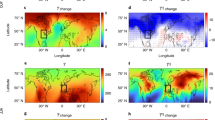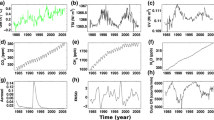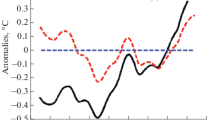Abstract
The use of pattern correlations to compare observed temperature changes with predicted anthropogenic effects has greatly increased our confidence in the reality of these effects. Here we use synthetic observed data to determine the expected behavior of the pattern correlation statistic, R(t), and hence clarify some results obtained in previous studies. We show that, for the specific case considered here (near-surface temperature changes), even with a perfectly-known signal, expected values of R(t) currently should be only of order 0.3–0.5, as observed; that R(t) may show markedly non-linear variations in time; that the CO2-alone signal pattern should be difficult to detect today primarily because of data coverage deficiencies; and why the signal due to combined CO2-aerosol forcing is easier to detect than either the CO2-alone or aerosol-alone signals. Finally, we show that little is to be gained at present by searching for a time-dependent signal compared with a representative constant signal pattern.
Similar content being viewed by others
Author information
Authors and Affiliations
Additional information
Received: 24 June 1996/Revised: 3 March 1998
Rights and permissions
About this article
Cite this article
Wigley, T., Jaumann, P., Santer, B. et al. Relative detectability of greenhouse-gas and aerosol climate change signals. Climate Dynamics 14, 781–790 (1998). https://doi.org/10.1007/s003820050254
Issue Date:
DOI: https://doi.org/10.1007/s003820050254




